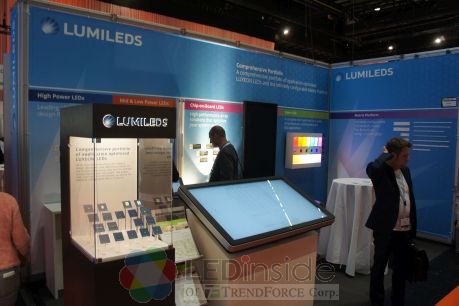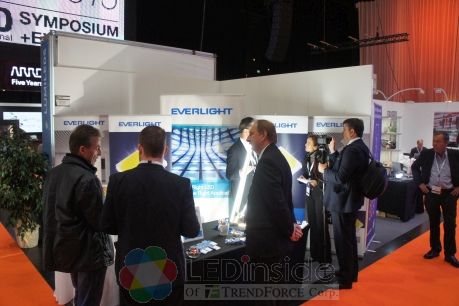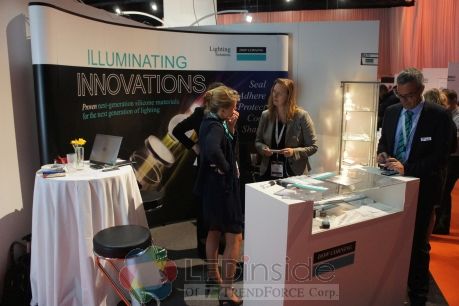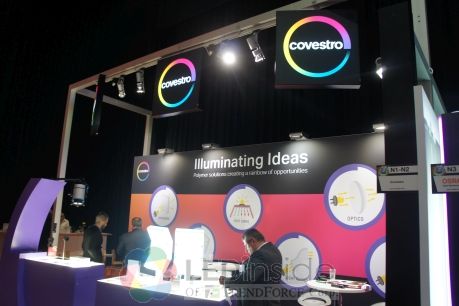Numerous experts from the lighting industry and research have come together in Bregenz to analyze trends and technologies for future SSL solutions at the 5th LED professional Symposium +Expo (LpS 2015). The atmosphere is inspiring with discussions and networking taking place throughout. Amongst the more than 100 well-known companies exhibiting this year are the world’s top LED manufacturers Nichia, Cree, Everlight, Lumileds, Osram, Samsung and Seoul Semiconductor. A total of eighteen products have been launched and the best scientific paper has been honored with the LED professional Scientific Award.
 |
|
Lumileds booth at LpS 2015 showcased the company's latest LED chip technologies. (LEDinside) |
The LpS 2015 started on September 22nd with an opening speech by Joe Niemela, Global Coordinator of IYL 2015 and continued with three keynotes by Professor Zary Segall – Endowed Chair Professor at The Royal Institute of Technology (KTH) in Stockholm, Rogier Van der Heide – Chief Design and Marketing Officer, Zumtobel Group and Jy Bhardwaj – Senior Vice President R&D, Lumileds. After the keynotes, which outlined the latest trends, technologies and applications, the lecture series with sixty presentations and seven workshops commenced. In the course of the opening, the scientific award was given to Dr. Wolfgang Nemitz for his paper on an interactive optical and thermal simulation method for proper simulations of phosphor covered LEDs.
 |
|
Rogier Van der Heide, Chief Design and Marketing Officer, Zumtobel Group was one of the keynote speakers at LpS 2015. (Photo courtesy of LED Professional) |
Technology Focus
The technical lectures at the LpS 2015 cover the whole of the LED light value chain, from electronic components to complete lighting system. They focus on light sources, smart controls and drivers, optics, light quality, light mixing, connectivity, security, reliability and lifetime, standardization, light measurement, production and lighting systems. Top authorities from the lighting industry, like Dr. Daniel Doxsee, deputy-managing director at Nichia, are in Bregenz this week. While Dr. Doxsee talked about LED light for visual merchandising, Prof. Zissis from the Toulouse 3 University in France gave a talk on: “Quality of Lamps and Associated Health Issues”, and SSL expert Alexander Wilm from Osram Opto Semiconductor gave a report on a reality lifetime check of LED lighting systems.
 |
|
Semantic Light and other human centric lighting technologies were highlighted at this year's LpS. (LEDinside) |
The technological focus of the event can also be seen at the exhibition, where over one hundred well-known companies, including the world’s top LED manufacturers Nichia, Cree, Everlight, Lumileds, Osram, Samsung and Seoul Semiconductor showcased their latest products and services. There were also a total of eighteen product launches made here. A highlight of the exhibition is the color portfolio from Lumileds, where all physical parameters of the LEDs out of the series are homogenized so that one lens fits all colors despite different LED technologies. Marula LED introduced their new MA 1077 Driver IC, which ensures transformer compatibility of low voltage LED lamps and Escatec showcased a new heat spreader solution for LEDs which are soldered onto a copper substrate that is up to ten times more effective at dissipating heat than current solutions. Another highlight of the exhibition is the new BMW i8 with laser headlights.
 |
 |
 |
|
Manufacturer booths at the show from top to bottom: Everlight, Dow Corning, and Covestro, which was formerly known as Bayer Material Science company. (LEDinside) |
Design meets Technology Day
In addition to the technical event program a “Design meets Technology Day” took place on the first day of the event that enabled a collaboration and dialogue between engineers and technicians as well as lighting designers, planners and architects. Architects and lighting planners were taken through the exhibition in small groups. The tour included demonstrations and product presentations across the lighting value chain. Furthermore, sixteen students showcased their lighting design prototypes. These prototypes are the result of a four-month long design contest, devised by the University of Applied Sciences in Munich and Seoul Semiconductor. The most interesting prototypes were honored as a part of the Design meets Technology Day. According to the jury it was extremely difficult to choose a winner, as all prototypes were so different in their designs and application. Finally they agreed not to award any of the projects but to highlight one prototype that was the most interesting from a technical point of view: a construction lamp from Lena Gillitzer. It wouldn’t be possible to build her lamp without the driverless Acrich technology invented by Seoul Semiconductor.

















